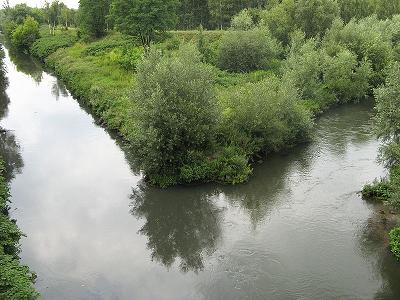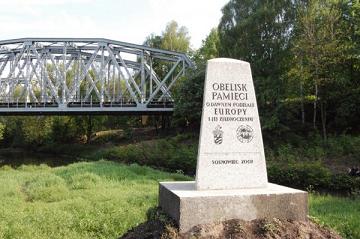The Triangle of Three Emperors from German Dreikaisereck is a term which determines the place, where from 1846 to the First World War (1915) crossed the borders of three European powers: Prussia (later Germany), Austria (later Austria-Hungary) and Russia. Their confluence was established after the liquidation of the Cracow Republic in 1846. The borders ran along rivers: White and Black Przemsza and Przemsza. Currently, these are the areas of cities: Mysłowice (districts Brzęczkowice and Słupna) and Sosnowiec (districts Modrzejów and Jęzor). If you would look at the period when the term was applied, then from he Prussian side the border towns were: Brzęczkowice / Słupna, Modrzejów from the Russian side, and Jęzor from the Austrian side (at that time, a part of Jaworzno). In 1956 Jęzor was transferred administratively to Sosnowiec. Therefore, the areas of the former borders of three empires are now within just two cities. It is also worth mentioning that although the in that point were crossing the frontiers of three countries participating in the Partitions of Poland, does not mean, that this was a meeting point between the Polish lands before the partition, because the areas lying to the west of Przemsza in this place were the Prussian already before the first Partition of Poland. The name "triangle" is a copy from the German language (Dreieck in German means a triangle) and was adopted since the division of land, where the river forks formed the divided areas of into three parts. So it meant a point of confluence of the rivers, in which White Przemsza connects with the Black Przemsza (from that point the river is named just Przemsza) and thus crossed borders of three empires. Often mistakenly Triangle of Three Emperors is identified, with a site of which the southern tip is now at the limits of Sosnowiec (then Modrzejów) in the shape of a triangle. In addition, the German word Dreiländereck means a triple point of contact.

"This place to the end of World War was known almost all Europe. In this place arrived trips, on the river swam barges and two small steamers, which were used by hikers, they were also able to admire the magnificent views from the tower and shop in cross-border stalls. This place was famous for Bismarck Tower built in 1907, which was located on a hillside called Słupecka hillock, it was a great tourist attraction. Built according to the design of Wilhelm Kreis from Dresden, from specially prepared stone blocks, she had more than 20m high, was topped with a large terrace, towards which led the stairs. The visitors had a view on the landscape around the border, and in clear days one could supposedly see Krakow. From the tower the view was overlooking the areas of Niwki, Modrzejów, Sosnowiec and Grodziec. One could easily see the towers of Catholic churches and domed towers of Russian Orthodox Church. The visitors had a view on the landscape around the border, and in clear days one could supposedly see Krakow. Tower went through the Silesian uprisings, during which it was used as an observation point. Shelled by German artillery and thereby damaged. After joining Mysłowice to Poland the name was changed to Insurgents Tower. After repairing the damages the tower was named after Tadeusz Kosciuszko. This act was emphasized by setting a special bronze memory board with the bust of the chief. In 1937, the City Council in Myslowice decided to destroy of the tower, what took place in 1938. Elements of the demolished tower were used in form of large stone blocks as building a building material, among others in the stairs in Church of Our Lady of Sorrows and in the Cathedral of Christ the King in Katowice. There are reliable sources indicating that the trace of the granite building blocks can be also found on the Wawel Hill. On the bridge located here, Austrian and German gendarmes and customs officers checked the trains from Mysłowice to Szczakowa and vice versa. On the shores of the Black Przemsza, an attraction on the side of Russian annexation were the Tsarist border guards, dressed in a beautiful, colorful uniforms and tall hats, patrolling the border areas on foot or on horseback. After descending from the hill, a unique attraction for the visitors were two small steamers and festively decorated with colorful sashes and ribbons barges, called galleys moored in the port under the bridge for pedestrians which was leading to Galicia. They were used to cruise towards Brzęczkowice, Birkenau, and Wysoki Brzeg. Navigation on Przemsza was very popular among tourists, so the marina was besieged by visitors, willing to participate in the cruise voyages. A special attraction for the tourists was a trip through the areas of border bridges on the Austrian and Russian annexations. Entering so called New Galicia tourists could see the vast cultural contrasts and visually see the "poverty of Galicia." Along the bank of Przemsza were a several dozens of wooden booths and stalls in which poor Polish people were selling meat, flour, legumes, fruits and vegetables. From the information in local newspapers steamed that the site hosted from 3 to 8 of thousands of tourists every week who came by train from the Upper and Lower Silesia, as well as very remote areas of the German Reich. The area was compared with Venice. For example at that time in Mysłowice were 70 restaurants, in today's world just 7. The border actually ceased to exist in this place in 1915 after the occupation of the Congress Kingdom by Germany and Austria-Hungary. Triangle of Three Emperors formally disappeared in 1918.
History after the war
Since the end of World War II, the place began to fall into oblivion. The day after the Polish accession to the European Union, May 2, 2004 took place in the Triangle a meeting of the presidents of cities: Jaworzno, Sosnowiec and Mysłowice and a memory board with an inscription: "In the place where once were crossing the borders of the three partitions, today we celebrate the Polish accession to the European Union and we are proud that together we build a Europe without borders." was mounted, November 9, 2007, on the occasion of the upcoming Independence Day, was unveiled with the cooperation of the authorities of Sosnowiec and PTTK a memorial obelisk, on which the inscription: Remembrance Obelisk of the ancient division of Europe and its unification. Currently, the city council of Myslowice with the authorities of the Museum of the City of Mysłowice prepares a revitalization program for the Triangle. On the old disused railway bridge will be built a viewing platform, and bicycle paths around the whole area will be created. A commemorating historical center of the story of that place will also be built.
